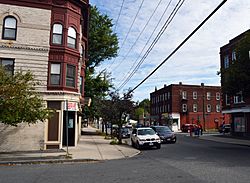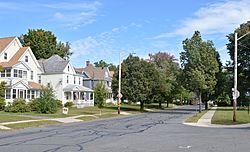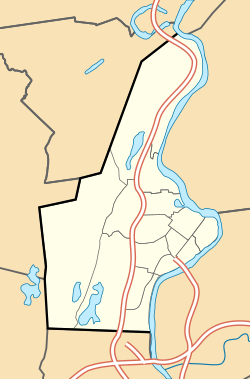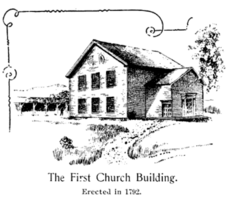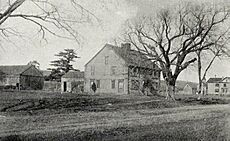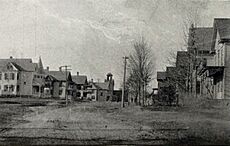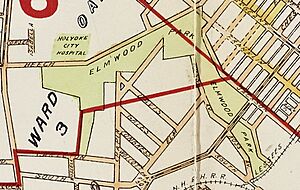Elmwood, Holyoke, Massachusetts facts for kids
Quick facts for kids
Elmwood
|
|
|---|---|
|
Top to bottom: Elmwood's commercial center, featuring blocks by George P. B. Alderman; neighborhood homes across from Laurel Park
|
|
| Country | United States |
| State | Massachusetts |
| City | Holyoke |
| Wards | 3 |
| Precincts | 3A, 3B |
| Settled | c. 1725 |
| Area | |
| • Total | 0.798 sq mi (2.07 km2) |
| Elevation | 253 ft (77 m) |
| ZIP code |
01040
|
| Area code(s) | 413 |
| GNIS feature ID | 609000 |
| MACRIS ID | HLY.D |
Elmwood is a neighborhood in Holyoke, Massachusetts. It's located south of the city center. This area is about 1 mile (1.6 km) from downtown Holyoke.
Elmwood is actually Holyoke's oldest village. It existed even before the Hadley Falls Dam was built. It started as part of West Springfield's "Ireland Parish." It was first called Baptist Village. This name came from the First Baptist Church, which is Holyoke's oldest church. It was officially started in 1803, but people met there since 1792.
Today, Elmwood has many beautiful Victorian houses. It also has about 510 acres (210 ha) of homes and businesses. You can find Holyoke High School, William R. Peck Middle School, Fitzpatrick Ice Skating Rink, and Mackenzie Stadium here.
Contents
Elmwood's History
Early Beginnings
Baptist Village began around 1725. That year, five people were baptized in the Connecticut River. This happened near what is now the Elmwood Cemetery.
In its early years, traveling preachers visited the community often. People wanted to build a place to worship. The first Baptist Church was officially formed in 1803. But in 1792, the first meetinghouse was built. People called it the "Lord's barn" because it wasn't fully finished. It was described as "plain" at first.
By 1801, another church group, the Congregationalists, asked to use the building. They offered to finish it and add seats. The Baptists agreed. The building was later moved to Northampton Street. Today, the Blessed Sacrament and Metcalf Schools stand there.
First Settlers and Their Homes
Some of the first families in the village were the Elys, Chapins, Days, Balls, Rands, Humestons, and Streets. They built their homes near the village. The Ely family lived in the area between Brown Avenue and Northampton Street.
Enoch Ely was a soldier in the American Revolution. After the war, he joined Shays' Rebellion. This was a protest against taxes that soldiers felt were unfair. To avoid arrest, Enoch hid in the nearby woods. Soldiers couldn't find him, so they shot at his front door. The bullet holes stayed on the doors for many years.
After several generations, the Ely homestead was owned by four siblings who never married. Around the 1850s or 1860s, Horace Brown bought the home. Brown Avenue is named after him today.
Neighborhood Growth
In the 1860s and 1870s, German settlers came to the area. Horace Brown tried to sell his land to one of them for $300. But the person refused, saying the land was not good for farming.
After 1887, the neighborhood grew quickly. William S. Loomis bought a large piece of land. He planned to build homes there. He asked the Holyoke Street Railway to extend their horsecar lines to Elmwood. They said no.
So, Loomis bought enough company stock to take control of the railway. He then immediately moved forward with his plan. The neighborhood grew a lot when the streetcar lines became electric. This made it easy for residents to travel to factories for work. Elmwood became more connected to Holyoke as more homes were built. Workers could easily get around using the streetcar and later, the bus system.
Elmwood Park's Story
Around 1899, work began on Elmwood Park. In 1902, the Holyoke Water Power Company gave land to the city for the park. It was a long, narrow park along Dry Brook. It stretched from the old Yankee Pedlar house towards the Connecticut River. The famous Olmsted Brothers designed it. Because of its hilly land, it was also called Dingle Park.
In the 1960s, the new Holyoke High School was built. This started to break up the park. When I-391 was built, the city paid the Holyoke Water Power Company for using the park land for other purposes.
Today, not much of the park is left. The high school, Peck School, some houses, Mackenzie Stadium, and the I-391 on-ramp now cover much of it. You can still see one of its original decorative staircases at Sheard Park. This park is at the corners of Maple and Jackson Streets. Crozier Field is at the other end of the original park area. On maps from the mid-1900s, Sheard Park was still called Elmwood Park.


